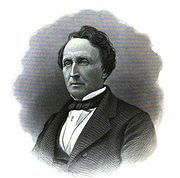
Bates Mill
Encyclopedia

Lewiston, Maine
Lewiston is a city in Androscoggin County in Maine, and the second-largest city in the state. The population was 41,592 at the 2010 census. It is one of two principal cities of and included within the Lewiston-Auburn, Maine metropolitan New England city and town area and the Lewiston-Auburn, Maine...
. The mill served as Maine's largest employer through the 1960s, and early profits from the mill provided much of the initial capital for Bates College
Bates College
Bates College is a highly selective, private liberal arts college located in Lewiston, Maine, in the United States. and was most recently ranked 21st in the nation in the 2011 US News Best Liberal Arts Colleges rankings. The college was founded in 1855 by abolitionists...
. Currently, the mill buildings are home to several businesses and a small museum.
History

Benjamin E. Bates
Benjamin Edward Bates was a New England industrialist and philanthropist, who was the namesake and a founder of Bates College and the Bates Mill in Lewiston, Maine.-Biography:...
, a Boston
Boston
Boston is the capital of and largest city in Massachusetts, and is one of the oldest cities in the United States. The largest city in New England, Boston is regarded as the unofficial "Capital of New England" for its economic and cultural impact on the entire New England region. The city proper had...
entrepreneur, founded the textile mill in 1850 with several co-investors in the Bates Manufacturing Company. Maine Governor John Hubbard signed the incorporation act on August 16, 1850 and Mill #1 was completed in 1852. Bates built the mill in Lewiston due to its location at Lewiston Falls, which initially provided power to the mill. The Mill was operated by water power from the Androscoggin River
Androscoggin River
The Androscoggin River is a river in the U.S. states of Maine and New Hampshire, in northern New England. It is long and joins the Kennebec River at Merrymeeting Bay in Maine before its water empties into the Gulf of Maine on the Atlantic Ocean. Its drainage basin is in area...
, and combined power spinning
Spinning (textiles)
Spinning is a major industry. It is part of the textile manufacturing process where three types of fibre are converted into yarn, then fabric, then textiles. The textiles are then fabricated into clothes or other artifacts. There are three industrial processes available to spin yarn, and a...
and weaving
Weaving
Weaving is a method of fabric production in which two distinct sets of yarns or threads are interlaced at right angles to form a fabric or cloth. The other methods are knitting, lace making and felting. The longitudinal threads are called the warp and the lateral threads are the weft or filling...
on loom
Loom
A loom is a device used to weave cloth. The basic purpose of any loom is to hold the warp threads under tension to facilitate the interweaving of the weft threads...
s. The Mill produced textiles until the 21st century. During the American Civil War
American Civil War
The American Civil War was a civil war fought in the United States of America. In response to the election of Abraham Lincoln as President of the United States, 11 southern slave states declared their secession from the United States and formed the Confederate States of America ; the other 25...
, the factory produced textiles for the Union Army with southern cotton it had stockpiled prior to the War. Thousands of immigrants from Canada and Europe immigrated to Lewiston to gain employment at the mills. In 1992, the City of Lewiston took possession of the Bates Mill Complex after years of unpaid taxes. In 2001 voters eventually decided in a referendum to sell the Complex to Platz Associates, private developers. Platz refurbished the buildings and sold all but two of them.
Today
Currently, the rehabilitated Bates Mill Complex is the site of TD Bank and Androscoggin Savings Bank offices, several restaurants, and Museum L-AMuseum L-A
The full name of Museum L-A is the Museum L-A: The Story of Work and Community in Lewiston-Auburn. Located in Lewiston, Maine, USA, the museum focuses on the local history of the Industrial Revolution and the contributions and cultural heritage of its workers in the Lewiston-Auburn area...
: The Story of Work and Community in Lewiston-Auburn.
On July 15, 2009, Bates Mill Building No. 5 briefly caught on fire from embers from the nearby Cowan Mill
Cowan Mill
Cowan Mill was an historic mill at Island Mill Street in Lewiston, Maine....
which was completely destroyed by fire. Building No.5, a 356000 square feet (33,073.5 m²) weaving shed, was designed by Albert Kahn and placed in service in 1914. The structure is currently owned by the city of Lewiston, Maine
Lewiston, Maine
Lewiston is a city in Androscoggin County in Maine, and the second-largest city in the state. The population was 41,592 at the 2010 census. It is one of two principal cities of and included within the Lewiston-Auburn, Maine metropolitan New England city and town area and the Lewiston-Auburn, Maine...
, has been vacant for several years, and is slated for demolition (as of Fall, 2009).
On January 5, 2011, The Lofts at Bates Mill was awarded $5.2 million in low-income housing tax credits by the Maine State Housing Authority to convert Building No. 2 into 48 mixed-income apartments. The $9.2 million project is expected to include 33 subsidized apartments and 15 market-rate apartments. Construction is expected to begin in May or June of 2011.

